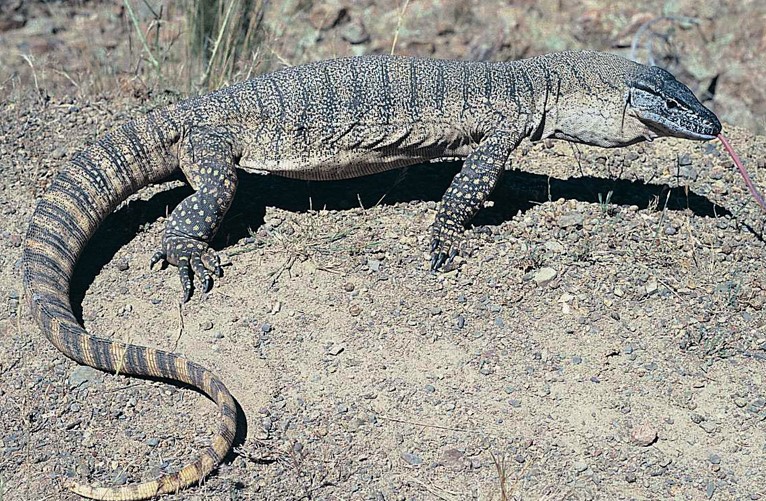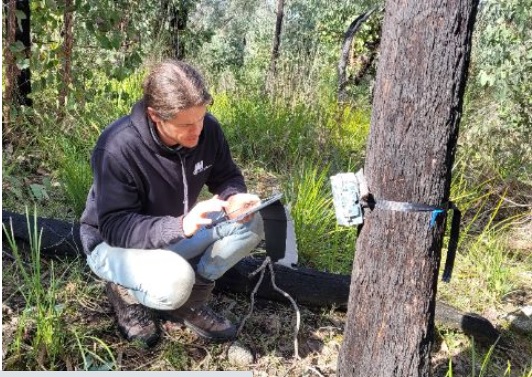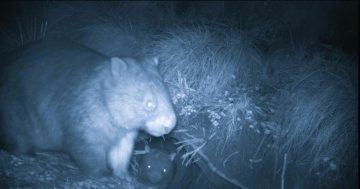
Listed as vulnerable – the heath goanna or Rosenberg’s Goanna (Varanus rosenbergi) – has been ‘accidentally’ discovered by a PhD research student in Woomargama National Park near Holbrook. Image: Ross Bennett.
With cameras trained on wombat burrows in Woomargama National Park near Holbrook, a university researcher working on his thesis has accidentally discovered a threatened species of goanna never-before-seen in that area.
PhD research student Grant Linley had been undertaking bushfire-affected environmental recovery monitoring in the south-west NSW wilderness area and said his research obtained photographic evidence of the heath goanna (Varanus rosenbergi).
Goanna is the name often used to refer to Australian (and some Asian) monitor lizards.
“This is unusual because the heath goanna (also known as Rosenberg’s goanna) is a very big lizard, up to one-and-a-half metres long, and is listed as a threatened species in both NSW and Victoria,” Mr Linley said.

“This is an interesting finding given this goanna’s conservation status,” CSU PhD research student Grant Linley said. “It’s an example of a species ‘hiding in plain sight’.” Photo: CSU.
Mr Linley is with Charles Sturt University’s Gulbali Institute of Agriculture, Water and Environment and said his study, Impacts of the 2019-20 Australian fires on terrestrial mammal communities in the foothill forests of south-eastern Australia, forms part of a wider investigation using camera traps to see how wildlife was affected by the 2019-20 wildfires in the Upper Murray.
Three areas in NSW and Victoria ─ Woomargama National Park, Burrowa-Pine Mountain National Park, and Jingellic Nature Reserve – form the research area.
One chapter of Mr Linley’s thesis explores which animals make use of wombat burrows throughout the region.
For his study of the burrows he placed 56 cameras on 28 burrows (one on a burrow and one nearby as a control).
They were all deployed for about the same amount of time, during a 10-month period starting on June 26, 2021.
By the time the study had finished – on April 28, 2022 – the number of images captured over 16,644 sampling days totalled 746,699.
Of these, 367,441 were wildlife images.
He said the images he captured of the heath goanna exiting a wombat burrow were opportunistic.
“This is an interesting finding given this goanna’s conservation status,” he said. “It’s an example of a species ‘hiding in plain sight’.”
Coupled with the fact the area has not been frequently surveyed in the past, the heath goanna had probably been sighted previously but may have not been identified correctly.
“It perhaps may have been mistaken for the similar but more common and well-known lace goanna (Varanus varius),” Mr Linley speculated.
Rosenberg’s is a ground dwelling monitor while the lace monitor is often found in trees.
Lace monitors are the second largest monitor lizard in Australia (the perentie (Varanus giganteus) being the largest). Averaging 1.5 metres in length, they can reach up to two metres.
The reproductive habits of the smaller heath monitor are closely associated with termite constructions, the above ground nest-mounds of some species, and is thought to rely on these to produce offspring, with female heath monitors laying up to 14 eggs.
Mr Linley has no data on the heath goanna population numbers, and he said they are very restricted throughout their known range due to habitat loss, introduced predators, and inappropriate fire regimes.
“They are a predator, so their diet consists of birds, mammals, reptiles, frogs and invertebrates, and as an opportunistic generalist predator, within their niche, they undoubtedly have an impact on the functioning of the ecosystem around them,” he said.
But he intends to update the Atlas of Living Australia with this new recorded sighting of the heath goanna.
Amid his research findings, Mr Linley says in general, the habitat is responding according to the severity of fire at which it was burnt.
“In terms of the very high severity areas, while they are recovering it will be decades before they resemble anything like what it was before the fires,” he said.
“The overall contrast in structure of the vegetations is extremely stark between burnt and unburnt areas, and we’re only beginning to learn what that means for the region’s wildlife.”








